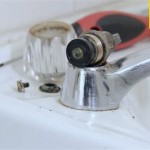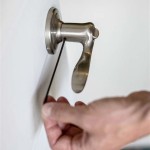Bathroom Sink Leaks Underneath: Identification, Causes, and Solutions
A leaking bathroom sink is a common household plumbing issue that can lead to water damage, mold growth, and increased water bills. Identifying the source of the leak underneath the sink is the first step toward resolving the problem effectively. This article provides a comprehensive overview of the potential causes of bathroom sink leaks, along with practical solutions to address them.
Identifying the Source of the Leak
Pinpointing the exact location of the leak is crucial for a successful repair. Begin by thoroughly inspecting all components located beneath the sink. Use a flashlight to illuminate the area, paying close attention to joints, connections, and areas showing signs of water damage or mineral buildup. Run the faucet and observe where the water is originating. A systematic approach will save time and prevent unnecessary repairs.
Start by feeling around each connection with a dry paper towel. The paper towel will become wet if there's a leak near that connection. Areas to inspect include:
- The faucet tailpiece connections
- The drain flange
- The P-trap
- The drain tailpiece
- The water supply lines
- The shut-off valves
Sometimes, the leak may not be immediately obvious. A slow drip might accumulate over time, creating a puddle that appears to originate from a different location. In these cases, drying the entire area beneath the sink with a towel and then slowly running the faucet while observing the components can help reveal the true source of the leak.
Common Causes of Bathroom Sink Leaks
Several factors can contribute to leaks underneath a bathroom sink. Understanding these common causes can assist in diagnosing the problem and implementing the appropriate solution.
Faulty Faucet Connections
The faucet is connected to the water supply lines via supply tubes that run through the underside of the sink. These connections are sealed with compression fittings or threaded couplings. Over time, these fittings can loosen due to temperature fluctuations, causing a leak. Additionally, the rubber or silicone washers within these connections can deteriorate, leading to water seepage. Another potential source of leaks comes from the faucet tailpiece, the part that connects the faucet to the drain. Similarly, the connections between the faucet body and the spout can leak, especially in older faucets with worn-out O-rings or seals.
Remedies for faucet connection leaks include tightening the fittings with a wrench, being careful not to overtighten and damage the pipes or fittings. Replacing worn-out washers or O-rings is also a viable solution. Disconnecting the water supply, dismantling the connection, and installing a new washer or O-ring is a relatively simple task that can prevent further leakage. If the faucet itself is corroded or severely damaged, replacing the entire faucet assembly may be the most effective solution.
Issues with the Drain Assembly
The drain assembly, consisting of the drain flange, tailpiece, P-trap, and drainpipe, is another common source of leaks. The drain flange, which sits inside the sink basin, is sealed to the sink with plumber’s putty or silicone sealant. Over time, this sealant can degrade, allowing water to seep through. The P-trap, a U-shaped pipe designed to trap debris and prevent sewer gases from entering the bathroom, can also develop leaks due to loose connections or cracks in the pipe.
Leaks from the drain flange require removing the drain assembly, cleaning the old sealant, and applying fresh plumber’s putty or silicone sealant before reassembling the drain. Properly tightening the nut that secures the drain flange is crucial to ensure a watertight seal. For leaks in the P-trap or drain tailpiece, check the slip nuts that connect the pipes. Tightening these nuts with a wrench may resolve the issue. If the pipes are cracked or corroded, replacing the entire P-trap or drain tailpiece is necessary.
Degradation of Water Supply Lines
The water supply lines, which connect the shut-off valves to the faucet, are typically made of flexible copper, braided stainless steel, or PEX. Over time, these lines can corrode, kink, or develop pinhole leaks due to pressure fluctuations or mineral buildup. The fittings connecting the supply lines to the shut-off valves and faucet can also loosen or corrode, leading to leaks.
Addressing leaks in the water supply lines involves inspecting the lines for any signs of damage or corrosion. If a pinhole leak is detected, replacing the entire supply line is recommended. Attempting to patch or repair the line is generally not a long-term solution. When replacing the supply lines, ensure that the new lines are of the correct length and material. Tighten the fittings securely, but avoid overtightening, which can damage the connections. It is generally recommended to replace both hot and cold water lines simultaneously to ensure consistent performance and prevent future issues.
Solutions for Common Leak Types
After identifying the source of the leak, specific solutions can be applied to address the problem effectively.
Tightening Loose Connections
Many leaks are simply caused by loose connections. Using a wrench, gently tighten the nuts and fittings on the water supply lines, drain assembly, and faucet connections. Avoid overtightening, as this can damage the pipes or fittings, potentially exacerbating the leak or causing new ones. A slight turn is often all that is needed to create a watertight seal. After tightening, run the faucet and check for any remaining leaks. If the leak persists, further investigation is necessary.
Replacing Washers and O-Rings
Worn-out washers and O-rings are a common cause of leaks in faucet connections. These small rubber or silicone components provide a seal between the different parts of the faucet and water supply lines. Over time, they can become brittle, cracked, or deformed, leading to water seepage. Replacing these components is a relatively inexpensive and straightforward solution.
To replace a washer or O-ring, first, shut off the water supply to the faucet. Disconnect the leaking connection and carefully remove the old washer or O-ring. Take the old component to a hardware store to ensure you purchase the correct replacement. Lubricate the new washer or O-ring with plumber’s grease before installing it. Reassemble the connection, ensuring that the new washer or O-ring is properly seated. Tighten the connection securely, but avoid overtightening. Turn on the water supply and check for leaks.
Using Plumber's Putty or Silicone Sealant
Leaks around the drain flange are often caused by deteriorated plumber’s putty or silicone sealant. To repair this type of leak, the drain assembly must be removed and reinstalled with fresh sealant. First, shut off the water supply and disconnect the drain pipes. Loosen the nut that secures the drain flange to the sink and carefully remove the drain assembly. Scrape away all the old plumber’s putty or silicone sealant from the sink basin and the drain flange. Clean the area thoroughly with a damp cloth.
Apply a generous bead of fresh plumber’s putty or silicone sealant around the underside of the drain flange. Press the drain flange firmly into the sink basin, ensuring that the sealant makes good contact with the sink. Reinstall the nut that secures the drain flange, tightening it evenly to create a watertight seal. Remove any excess sealant with a damp cloth. Reconnect the drain pipes and turn on the water supply to check for leaks.
Replacing Damaged Pipes and Fittings
If pipes or fittings are cracked, corroded, or otherwise damaged, they must be replaced. Small cracks can sometimes be temporarily patched with epoxy putty, but this is generally not a long-term solution. Replacing the damaged components is the most reliable way to prevent future leaks.
When replacing pipes or fittings, use the same type and size of material. PEX, copper, and PVC are common materials used in bathroom plumbing. Ensure that the new pipes and fittings are properly connected and sealed. Use pipe thread sealant or Teflon tape on threaded connections to prevent leaks. Tighten the connections securely, but avoid overtightening. After completing the repairs, turn on the water supply and check for leaks. If you are unsure about performing plumbing repairs, consulting a qualified plumber is always recommended.

Bathroom Sink Drain Leaking Around Threads Premier Plumbing Inc

How To Fix A Leaking Bathroom Sink Paschal Air Plumbing Electric

Common Sink Leaks You Could Probably Fix Yourself

Bathroom Sink Drain Leaking Around Threads Premier Plumbing Inc

Trap Leaking Under Bathroom Vanity Doityourself Com Community Forums

How To Fix Constant Leak Under Bathroom Bunnings Work Community

How To Fix Pipework A Tap Faucet Leaking Under The Sink

Hose Under Your Sink Is Leaking Here S What You Have To Do

How To Fix Bathroom Sink Drain Leaks Underneath Gasket Threads Solved

How Can I Stop My Sink From Leaking And Why Vent Inside Stinky Hometalk
Related Posts







